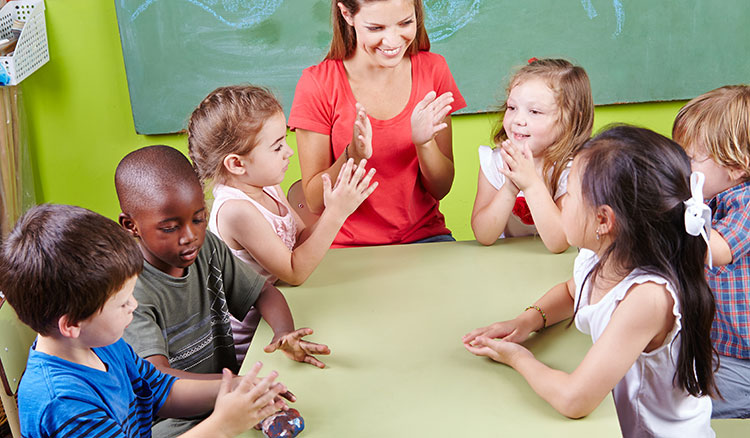E11: Clapping Names
1. Overview
Clap your hands for each syllable in a word or name. This game reinforces the idea that words with different numbers of syllables can be analyzed and broken into parts. This is the same activity as Drumming Names (E10), but with clapping instead of drumming. The clapping provides less kinesthetic feedback than drumming, so your child will have to listen for the syllables more than feeling them. This activity should be easy for children who have mastered feeling and drumming syllables.
E11: Clapping Names
2. Materials
- Script
- All you need for this activity is the same Word List you used for the previous activity, Drumming Names (E10).
3. Activity
Before starting the game, review with your child what a syllable is:Adult: You did a good job drumming the parts in all those words and names. Those parts are called syllables, remember? Say syllable. Child: Syllable.
Video: How to play Clapping Names
Now show your child how to clap the syllables in a variety of familiar words and names. Print out our word list (the same list from Drumming Names (E10)) for examples of words of different lengths. Use names of people and characters that are very familiar to him: family, pets, friends, and favorite fictional characters. Make sure you use names of varying syllable lengths: e.g., Jeff, Fido, Granny, Elizabeth, Uncle Julio, etc.
Start with a series of one-syllable words and names. Then move to two-syllable compound words, followed by two-syllable non-compound words.
Adult: I am going to say a name, and I am going to clap one time for each part, each syllable, of the name. You tell me how many parts you hear. Listen. Mom-my. Mom-my. [Say name clearly. Say it again, clearly, while clapping syllables.] Adult: Say it with me… Child and Adult: Mom-my. Adult: Say it again, and clap for each part of the word. Child: Mom [clap] – my [clap] Adult: Good job. Mommy is a word that has two parts, two syllables.Once your child grasps the concept, have her say each word with you and clap with you. Eventually she should be able to hear and clap the syllables on her own. When the child has the hang of hearing the difference between one-syllable and two-syllable words, move on to three-syllable words and names, and then a few four-syllable words and names. After introducing all the different word lengths, give the child a mix of some one- and two-syllable names. Once she has a solid grasp of one-and two-syllable names, throw some three- and eventually four-syllable words into the mix. Stick with this activity until the child has mastered the skill of hearing the difference between one- and two-syllable words and names. This is a critical step toward a child’s ability to hear the individual sounds in words later on. NOTE: For any error the child makes, have her repeat the use of her fingers under her chin and feel the number of syllables while she repeats the word. Then have her clap the word again. ↑ Top
4. Confidence Builder
The adult should model holding two fingers parallel to and touching under the chin while saying the word. Then help the child hold her fingers under her own chin. It is important that the child feel her chin move when uttering each syllable. ↑ Top5. Extension
Have your child clap out the syllables in longer names with four or five syllables. Examples: Aunt Elizabeth, Dora the Explorer, Tyrannosaurus. Stick with names that are very familiar to your child. (We adults know that each of these names are multiple words, but to children they are just one name, so you can use them to teach your child to count the syllables.) Alternately, vary the instructions with each word. First, she says the word while clapping; then she whispers the word while clapping; then she mouths the word silently while still clapping on each syllable. ↑ Top6. Variation
Let the child sit or stand and stomp out the number of syllables she hears with her feet. Or make it more of a game by having your child switch between clapping, tapping, and even knocking on each syllable. ↑ Top7. Small Groups (2-5 children)
Lesson Objective: Children will hear a word and repeat it while clapping out and then correctly identifying the number of syllables. GELDS (Georgia Early Learning & Development Standards): CLL6.4e Georgia Standards of Excellence: ELAGSEKRF2.b Common Core State Standards: CCSS.ELA-LITERACY.RF.K.2.B Adaptation: Read the main activity, watch the video, and follow the instructions above, with the following changes: Review by drumming each child’s name. Explain to the group, “Today we are going to clap names and words. Do you remember what the word parts are called? Syllables. Let’s tap syl-la-ble. Now let’s clap the word syllable. How many claps?” Practice with first and last names as well as words from the printed word list. Let children take turns calling out different group members’ names and then have the whole group clap out the syllables in the name that is called. Reinforcement: Sing “Where Is [Child’s Name]” to the tune of “Where is Thumbkin?” The child responds by clapping and saying his name. Use this Reinforcement at Home form to tell parents and guardians how they can reinforce lessons outside the classroom. ↑ TopLeave a Reply
